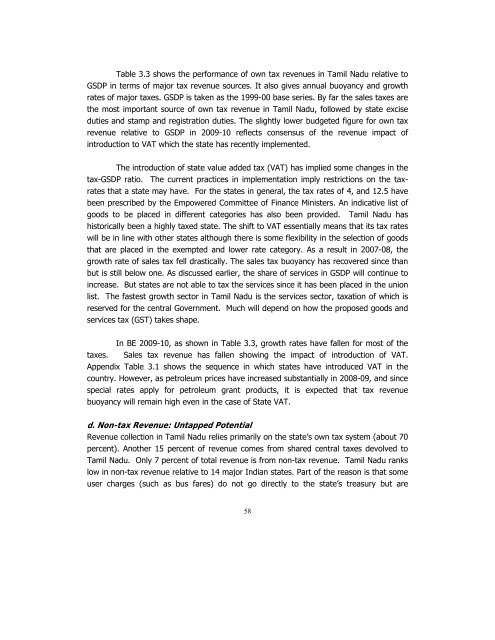POVERTY REDUCTION STRATEGY TN
You also want an ePaper? Increase the reach of your titles
YUMPU automatically turns print PDFs into web optimized ePapers that Google loves.
Table 3.3 shows the performance of own tax revenues in Tamil Nadu relative to<br />
GSDP in terms of major tax revenue sources. It also gives annual buoyancy and growth<br />
rates of major taxes. GSDP is taken as the 1999-00 base series. By far the sales taxes are<br />
the most important source of own tax revenue in Tamil Nadu, followed by state excise<br />
duties and stamp and registration duties. The slightly lower budgeted figure for own tax<br />
revenue relative to GSDP in 2009-10 reflects consensus of the revenue impact of<br />
introduction to VAT which the state has recently implemented.<br />
The introduction of state value added tax (VAT) has implied some changes in the<br />
tax-GSDP ratio. The current practices in implementation imply restrictions on the taxrates<br />
that a state may have. For the states in general, the tax rates of 4, and 12.5 have<br />
been prescribed by the Empowered Committee of Finance Ministers. An indicative list of<br />
goods to be placed in different categories has also been provided. Tamil Nadu has<br />
historically been a highly taxed state. The shift to VAT essentially means that its tax rates<br />
will be in line with other states although there is some flexibility in the selection of goods<br />
that are placed in the exempted and lower rate category. As a result in 2007-08, the<br />
growth rate of sales tax fell drastically. The sales tax buoyancy has recovered since than<br />
but is still below one. As discussed earlier, the share of services in GSDP will continue to<br />
increase. But states are not able to tax the services since it has been placed in the union<br />
list. The fastest growth sector in Tamil Nadu is the services sector, taxation of which is<br />
reserved for the central Government. Much will depend on how the proposed goods and<br />
services tax (GST) takes shape.<br />
In BE 2009-10, as shown in Table 3.3, growth rates have fallen for most of the<br />
taxes. Sales tax revenue has fallen showing the impact of introduction of VAT.<br />
Appendix Table 3.1 shows the sequence in which states have introduced VAT in the<br />
country. However, as petroleum prices have increased substantially in 2008-09, and since<br />
special rates apply for petroleum grant products, it is expected that tax revenue<br />
buoyancy will remain high even in the case of State VAT.<br />
d. Non-tax Revenue: Untapped Potential<br />
Revenue collection in Tamil Nadu relies primarily on the state’s own tax system (about 70<br />
percent). Another 15 percent of revenue comes from shared central taxes devolved to<br />
Tamil Nadu. Only 7 percent of total revenue is from non-tax revenue. Tamil Nadu ranks<br />
low in non-tax revenue relative to 14 major Indian states. Part of the reason is that some<br />
user charges (such as bus fares) do not go directly to the state’s treasury but are<br />
58

















